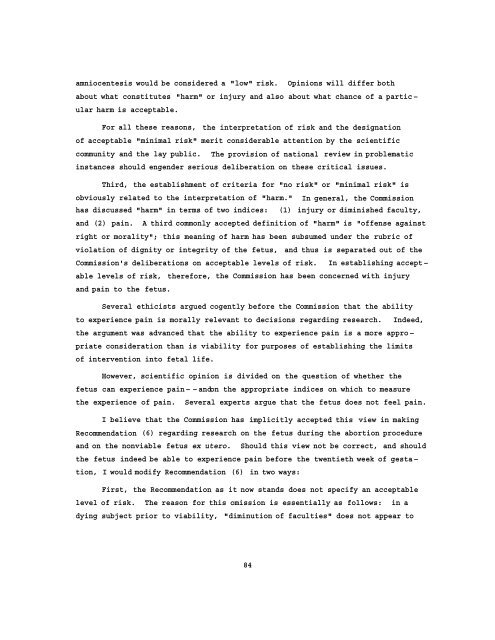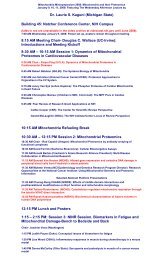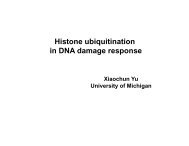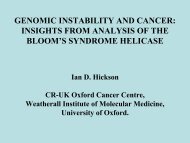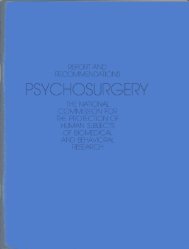RESEARCH ON THE FETUS - National Institutes of Health
RESEARCH ON THE FETUS - National Institutes of Health
RESEARCH ON THE FETUS - National Institutes of Health
Create successful ePaper yourself
Turn your PDF publications into a flip-book with our unique Google optimized e-Paper software.
amniocentesis would be considered a "low" risk. Opinions will differ both<br />
about what constitutes "harm" or injury and also about what chance <strong>of</strong> a particular<br />
harm is acceptable.<br />
For all these reasons, the interpretation <strong>of</strong> risk and the designation<br />
<strong>of</strong> acceptable "minimal risk" merit considerable attention by the scientific<br />
community and the lay public. The provision <strong>of</strong> national review in problematic<br />
instances should engender serious deliberation on these critical issues.<br />
Third, the establishment <strong>of</strong> criteria for "no risk" or "minimal risk" is<br />
obviously related to the interpretation <strong>of</strong> "harm." In general, the Commission<br />
has discussed "harm" in terms <strong>of</strong> two indices: (1) injury or diminished faculty,<br />
and (2) pain. A third commonly accepted definition <strong>of</strong> "harm" is "<strong>of</strong>fense against<br />
right or morality"; this meaning <strong>of</strong> harm has been subsumed under the rubric <strong>of</strong><br />
violation <strong>of</strong> dignity or integrity <strong>of</strong> the fetus, and thus is separated out <strong>of</strong> the<br />
Commission's deliberations on acceptable levels <strong>of</strong> risk. In establishing acceptable<br />
levels <strong>of</strong> risk, therefore, the Commission has been concerned with injury<br />
and pain to the fetus.<br />
Several ethicists argued cogently before the Commission that the ability<br />
to experience pain is morally relevant to decisions regarding research. Indeed,<br />
the argument was advanced that the ability to experience pain is a more appropriate<br />
consideration than is viability for purposes <strong>of</strong> establishing the limits<br />
<strong>of</strong> intervention into fetal life.<br />
However, scientific opinion is divided on the question <strong>of</strong> whether the<br />
fetus can experience pain--and on the appropriate indices on which to measure<br />
the experience <strong>of</strong> pain. Several experts argue that the fetus does not feel pain.<br />
I believe that the Commission has implicitly accepted this view in making<br />
Recommendation (6) regarding research on the fetus during the abortion procedure<br />
and on the nonviable fetus ex utero. Should this view not be correct, and should<br />
the fetus indeed be able to experience pain before the twentieth week <strong>of</strong> gestation,<br />
I would modify Recommendation (6) in two ways:<br />
First, the Recommendation as it now stands does not specify an acceptable<br />
level <strong>of</strong> risk. The reason for this omission is essentially as follows: in a<br />
dying subject prior to viability, "diminution <strong>of</strong> faculties" does not appear to<br />
84


